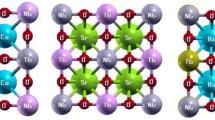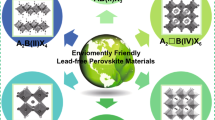Abstract
Two-dimensional (2D) hybrid metal halide perovskite is receiving more interest today due to being more stable and having a higher surface area-to-volume ratio than 3-dimensional (3D) hybrid metal halide perovskites. To create a 2D structure with high-efficiency properties, the A cation in the parental 3D structure should be replaced with a bulky organic cation (BOC). So in this study, we aim to investigate the structural, electrical, and optical characteristics of 2D (2-AMP)PbI4 via CASTEP computer code and density functional theory (DFT). The computations utilize the local density approximation (LDA) and the generalized gradient approximation (GGA) techniques. The structural characteristics of GGA-PBEsol demonstrate great agreement with experiment data. The (2-AMP)PbI4 structure consists of corner-sharing PbI64− octahedra separated by alternating sheets of the double-protonated 2-AMP cation. Due to the spin–orbit coupling (SOC) effect, the electronic band gap was reduced from 1.92 to 0.98 eV. According to the partial density of states (PDOS), the Pb-p and I-p bonds supply the most electrons to the band gap. When it comes to optical characteristics, the actual part of the dielectric function reveals that this compound exhibits plasmonic behavior, which increases its capacity to absorb light. The absorption coefficient of (2-AMP)PbI4 shows that this 2D compound able to absorb light in the range of UV and visible light, making it a possible candidate for high-efficiency solar cell devices.





Similar content being viewed by others
Data Availability
Crystallographic data for the structure used in this article have been accessed through Cambridge Crystallographic Data Centre, under deposition numbers CCDC 1838613. Copies of the data can be obtained free of charge via https://www.ccdc.cam.ac.uk/structures/. All other relevant data generated and analysed during this study which include computational data, are included within the article.
References
P. Basumatary, P. Agarwal, A short review on progress in perovskite solar cells. Mater. Res. Bull. 149, 111700 (2022). https://doi.org/10.1016/j.materresbull.2021.111700
J.J. Yoo, S.S. Shin, J. Seo, Toward efficient perovskite solar cells: progress, strategies, and perspectives. ACS Energy Lett. 7(6), 2084–2091 (2022). https://doi.org/10.1021/acsenergylett.2c00592
J. Seo, J.H. Noh, S. Il Seok, Rational strategies for efficient perovskite solar cells. Acc. Chem. Res. 49(3), 562–572 (2016). https://doi.org/10.1021/acs.accounts.5b00444. (American Chemical Society)
H. Dong, C. Ran, W. Gao, M. Li, Y. Xia, W. Huang, Metal halide perovskite for next-generation optoelectronics: progresses and prospects. eLight 3(1), 3 (2023). https://doi.org/10.1186/s43593-022-00033-z
A.S.R. Bati, Y.L. Zhong, P.L. Burn, M.K. Nazeeruddin, P.E. Shaw, M. Batmunkh, Next-generation applications for integrated perovskite solar cells. Commun. Mater. 4(1), 2 (2023). https://doi.org/10.1038/s43246-022-00325-4
T.A. Chowdhury, M.A. Bin Zafar, M. Sajjad-Ul Islam, M. Shahinuzzaman, M.A. Islam, M.U. Khandaker, Stability of perovskite solar cells: issues and prospects. RSC Adv. 13(3), 1787–1810 (2023). https://doi.org/10.1039/D2RA05903G
M.S. Hasan et al., Recent criterion on stability enhancement of perovskite solar cells. Processes 10(7), 1408 (2022). https://doi.org/10.3390/pr10071408
X. Guan et al., Low-dimensional metal-halide perovskites as high-performance materials for memory applications. Small 18(38), 2203311 (2022). https://doi.org/10.1002/smll.202203311
M.D. Malouangou et al., Recent progress in perovskite materials using diammonium organic cations toward stable and efficient solar cell devices: Dion–Jacobson. Energy Technol. 10(5), 2101155 (2022). https://doi.org/10.1002/ente.202101155
H.B. Lee, N. Kumar, B. Tyagi, S. He, R. Sahani, J.-W. Kang, Bulky organic cations engineered lead-halide perovskites: a review on dimensionality and optoelectronic applications. Mater. Today Energy 21, 100759 (2021). https://doi.org/10.1016/j.mtener.2021.100759
T.L. Leung, I. Ahmad, A.A. Syed, A.M.C. Ng, J. Popović, A.B. Djurišić, Stability of 2D and quasi-2D perovskite materials and devices. Commun. Mater. 3(1), 63 (2022). https://doi.org/10.1038/s43246-022-00285-9
P.P. Mohanty, R. Ahuja, S. Chakraborty, Progress and challenges in layered two-dimensional hybrid perovskites. Nanotechnology 33(29), 292501 (2022). https://doi.org/10.1088/1361-6528/ac6529
T. Xu, W. Xiang, D.J. Kubicki, Y. Liu, W. Tress, S. Liu, Simultaneous lattice engineering and defect control via cadmium incorporation for high-performance inorganic perovskite solar cells. Adv. Sci. 9(36), 2204486 (2022). https://doi.org/10.1002/advs.202204486
C. Lermer et al., Completing the picture of 2-(aminomethylpyridinium) lead hybrid perovskites: insights into structure, conductivity behavior, and optical properties. Chem. Mater. 30(18), 6289–6297 (2018). https://doi.org/10.1021/ACS.CHEMMATER.8B01840
J. Zhang et al., Exploring spin-orbital coupling effects on photovoltaic actions in Sn and Pb based perovskite solar cells. Nano Energy 38, 297–303 (2017). https://doi.org/10.1016/j.nanoen.2017.05.061
H. Wang, A. Tal, T. Bischoff, P. Gono, A. Pasquarello, ‘Accurate and efficient band-gap predictions for metal halide perovskites at finite temperature.’ npj Comput. Mater. 8(1), 237 (2022). https://doi.org/10.1038/s41524-022-00869-6
Z. Xiao, Y. Yan, Progress in theoretical study of metal halide perovskite solar cell materials. Adv. Energy Mater. 7(22), 1701136 (2017). https://doi.org/10.1002/AENM.201701136
M. Pazoki, R. Imani, A. Röckert, T. Edvinsson, Electronic structure of 2D hybrid perovskites: Rashba spin–orbit coupling and impact of interlayer spacing. J. Mater. Chem. A 10(39), 20896–20904 (2022). https://doi.org/10.1039/D2TA05255E
Y. Nouri et al., The structural, mechanical, thermal, electronic and optical properties of halide perovskites. Solid State Commun. 363, 115087 (2023). https://doi.org/10.1016/j.ssc.2023.115087
S. Sami et al., Strategies for enhancing the dielectric constant of organic materials. J. Phys. Chem. C 126(45), 19462–19469 (2022). https://doi.org/10.1021/acs.jpcc.2c05682
S.K. Cushing, N. Wu, Plasmon-enhanced solar energy harvesting. Electrochem. Soc. Interface 22(2), 63–67 (2013). https://doi.org/10.1149/2.F08132IF/XML
H. Niu, Y. Xie, J. Shao, T. Ye, T. wen Li, Synergy light-trapping-enhanced solar energy conversion in DSSCs containing texture pit and silver nanoparticles. Mater. Sci. Semicond. Process. 148, 106774 (2022). https://doi.org/10.1016/j.mssp.2022.106774
N. Hasan, M. Arifuzzaman, A. Kabir, Structural, elastic and optoelectronic properties of inorganic cubic FrBX 3 (B = Ge, Sn; X = Cl, Br, I) perovskite: the density functional theory approach. RSC Adv. 12(13), 7961–7972 (2022). https://doi.org/10.1039/D2RA00546H
Acknowledgements
This work is funded by the Ministry of Higher Education (MOHE) via the Fundamental Research Grant Scheme (FRGS/1/2021/STG07/UITM/02/7). The authors would like to thank Universiti Teknologi Mara (UiTM), Ionics Materials & Devices (iMADE) Research Laboratory for their support in providing research facilities for this research and the postdoc Dr. Mohd Hazrie Samat for computational assistance.
Funding
This work was supported by the Ministry of Higher Education (MOHE) via the Fundamental Research Grant Scheme (FRGS/1/2021/STG07/UITM/02/7). A. Ramli receives research support from Fundamental Research Grant Scheme Phase 1 in 2021.
Author information
Authors and Affiliations
Contributions
All authors contributed to the study’s conception and design. Material simulation, data collection, and analysis were performed by Nur Fatin Najihah Abdul Yami, Nur Hamizah Mohd Zaki, and Azliana Ramli. Wan Izhan Nawawi Wan Ismail, Ab Malik Marwan Ali, Mohamad Fariz Mohamad Taib, Oskar Hasdinor Hassan, Suhaila Sepeai, and Suhaida Dila Safian supervised the content and the flow of the paper. The first draft of the manuscript was written by Fatin Najihah Abdul Yami, and all authors commented on previous versions of the manuscript. All authors read and approved the final manuscript.
Corresponding author
Ethics declarations
Competing interest
The authors declare no competing interests.
Rights and permissions
Springer Nature or its licensor (e.g. a society or other partner) holds exclusive rights to this article under a publishing agreement with the author(s) or other rightsholder(s); author self-archiving of the accepted manuscript version of this article is solely governed by the terms of such publishing agreement and applicable law.
About this article
Cite this article
Yami, N.F.N.A., Ramli, A., Nawawi, W.I. et al. Structural, electronic, and optical properties of lower-dimensional hybrid perovskite lead-iodide frameworks + SOC via density functional theory. emergent mater. 6, 999–1007 (2023). https://doi.org/10.1007/s42247-023-00484-1
Received:
Accepted:
Published:
Issue Date:
DOI: https://doi.org/10.1007/s42247-023-00484-1




